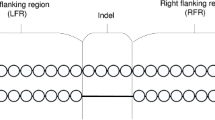Abstract
Multiple Sequence Alignment (MSA) is an essential tool in protein structure modeling, gene and protein function prediction, DNA motif recognition, phylogenetic analysis, and many other bioinformatics tasks. Therefore, improving the accuracy of multiple sequence alignment is an important long-term objective in bioinformatics. We designed and developed a new method MSACompro to incorporate predicted secondary structure, relative solvent accessibility, and residue–residue contact information into the currently most accurate posterior probability-based MSA methods to improve the accuracy of multiple sequence alignments. Different from the multiple sequence alignment methods that use the tertiary structure information of some sequences, our method uses the structural information purely predicted from sequences. In this chapter, we first introduce some background and related techniques in the field of multiple sequence alignment. Then, we describe the detailed algorithm of MSACompro. Finally, we show that integrating predicted protein structural information improved the multiple sequence alignment accuracy.
Access this chapter
Tax calculation will be finalised at checkout
Purchases are for personal use only
Similar content being viewed by others
References
Barton GJ, Sternberg M (1987) A strategy for the rapid multiple alignment of protein sequences. Confidence levels from tertiary structure comparisons. J Mol Biol 198(2):327
Feng DF, Doolittle RF (1987) Progressive sequence alignment as a prerequisitetto correct phylogenetic trees. J Mol Evol 25(4):351–360
Krogh A, Brown M, Mian IS, Sjolander K, Haussler D (1994) Hidden Markov models in computational biology: applications to protein modeling. J Mol Biol 235(5):1501–1531
Liu Y, Schmidt B, Maskell DL (2010) MSAProbs: multiple sequence alignment based on pair hidden Markov models and partition function posterior probabilities. Bioinformatics 26(16):1958–1964
Do CB, Mahabhashyam MSP, Brudno M, Batzoglou S (2005) ProbCons: probabilistic consistency-based multiple sequence alignment. Genome Res 15(2):330–340
Poirot O, Suhre K, Abergel C, O’Toole E, Notredame C (2004) 3DCoffee@ igs: a web server for combining sequences and structures into a multiple sequence alignment. Nucleic Acids Res 32(Suppl 2):W37–W40
Heringa J (1999) Two strategies for sequence comparison: profile-preprocessed and secondary structure-induced multiple alignment. Comput Chem 23(3):341–364
Kim NK, Xie J (2006) Protein multiple alignment incorporating primary and secondary structure information. J Comput Biol 13(9):1615–1629
Subramanian AR, Hiran S, Steinkamp R, Meinicke P, Corel E, Morgenstern B (2010) DIALIGN-TX and multiple protein alignment using secondary structure information at GOBICS. Nucleic Acids Res 38(Suppl 2):W19–W22
Zhou H, Zhou Y (2005) SPEM: improving multiple sequence alignment with sequence profiles and predicted secondary structures. Bioinformatics 21(18):3615–3621
Pei J, Grishin NV (2006) MUMMALS: multiple sequence alignment improved by using hidden Markov models with local structural information. Nucleic Acids Res 34(16):4364–4374
Pei J, Grishin NV (2007) PROMALS: towards accurate multiple sequence alignments of distantly related proteins. Bioinformatics 23(7):802–808
Cheng J, Randall A, Sweredoski M, Baldi P (2005) SCRATCH: a protein structure and structural feature prediction server. Nucleic Acids Res 33(Web Server Issue):W72–W76
Gonnet GH, Cohen MA, Benner SA (1992) Exhaustive matching of the entire protein sequence database. Science 256(5062):1443–1445
Kawabata T, Nishikawa K (2000) Protein structure comparison using the Markov transition model of evolution. Proteins 41(1):108–122
Durbin R, Eddy SR, Krogh A, Mitchison G (1998) Biological sequence analysis: probabilistic models of proteins and nucleic acids. Cambridge University Press, Cambridge, MA
Tegge AN, Wang Z, Eickholt J, Cheng J (2009) NNcon: improved protein contact map prediction using 2D-recursive neural networks. Nucleic Acids Res 37(Suppl 2):W515–W518
Sneath PHA, Sokal RR (1973) Numerical taxonomy. The principles and practice of numerical classification. Freeman, San Francisco, CA
Barney B (2011) OpenMP tutorial
Thompson JD, Koehl P, Ripp R, Poch O (2005) BAliBASE 3.0: latest developments of the multiple sequence alignment benchmark. Proteins 61(1):127–136
Van Walle I, Lasters I, Wyns L (2004) Align-m—a new algorithm for multiple alignment of highly divergent sequences. Bioinformatics 20(9):1428–1435
Raghava GPS, Searle SMJ, Audley PC, Barber JD, Barton GJ (2003) OXBench: a benchmark for evaluation of protein multiple sequence alignment accuracy. BMC Bioinformatics 4(1):47
Thompson JD, Plewniak F, Poch O (1999) A comprehensive comparison of multiple sequence alignment programs. Nucleic Acids Res 27(13):2682–2690
Deng X, Cheng J (2011) MSACompro: protein multiple sequence alignment using predicted secondary structure, solvent accessibility, and residue-residue contacts. BMC Bioinformatics 12:472
Acknowledgment
This work was supported by an NIH grant (1R01GM093123) to JC.
Author information
Authors and Affiliations
Editor information
Editors and Affiliations
Rights and permissions
Copyright information
© 2014 Springer Science+Business Media, LLC
About this protocol
Cite this protocol
Deng, X., Cheng, J. (2014). MSACompro: Improving Multiple Protein Sequence Alignment by Predicted Structural Features. In: Russell, D. (eds) Multiple Sequence Alignment Methods. Methods in Molecular Biology, vol 1079. Humana Press, Totowa, NJ. https://doi.org/10.1007/978-1-62703-646-7_18
Download citation
DOI: https://doi.org/10.1007/978-1-62703-646-7_18
Published:
Publisher Name: Humana Press, Totowa, NJ
Print ISBN: 978-1-62703-645-0
Online ISBN: 978-1-62703-646-7
eBook Packages: Springer Protocols




